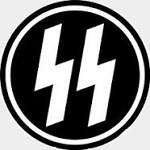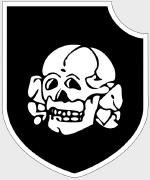Dragon DRR63279 German Mid Production Sd. Kfz. 142 Sturmgeschutz III Ausf. G Assault Gun with Schurzen Side Skirts - 3.SS Panzer Division "Totenkopf", Kursk, Russia, 1943 [With Foliage] (1:72 Scale)
"We must do everything we can to promote anti-tank defense, and work just as hard to guarantee successful counter-attacks through the instrument of powerful tank forces of our own."
- Major-General Heinz Guderian, "Achtung Panzer!"
 The Sturmgeschutz III (StuG III) assault gun was Germany's most-produced armored fighting vehicle during World War II. It was built on the chassis of the proven Panzer III tank, replacing the turret with an armored, fixed superstructure mounting a more powerful gun. Initially intended as a mobile assault gun for direct-fire support for infantry, the StuG III was continually modified, and much like the later Jagdpanzer, was widely employed as a tank destroyer.
The Sturmgeschutz III (StuG III) assault gun was Germany's most-produced armored fighting vehicle during World War II. It was built on the chassis of the proven Panzer III tank, replacing the turret with an armored, fixed superstructure mounting a more powerful gun. Initially intended as a mobile assault gun for direct-fire support for infantry, the StuG III was continually modified, and much like the later Jagdpanzer, was widely employed as a tank destroyer.
The Sturmgeschutz originated from German experiences in World War I, when it was discovered that, during the offensives on the Western Front, the infantry lacked the means to effectively engage fortifications. The artillery of the time was heavy and not mobile enough to keep up with the advancing infantry to destroy bunkers, pillboxes, and other minor fortifications with direct fire. Although the problem was well known in the German army, it was General Erich von Manstein who is considered the father of the Sturmartillerie ("assault artillery"). This is because the initial proposal was from (then) Colonel Erich von Manstein and submitted to General Ludwig Beck in 1935, suggesting that Sturmartillerie units should be used in a direct-fire support role for infantry divisions. On June 15th, 1936, Daimler-Benz AG received an order to develop an armored infantry support vehicle capable of mounting a 75 mm (2.95 in) calibre artillery piece. The gun mount's fixed, fully integrated casemate superstructure was to allow a limited traverse of a minimum of 25 degrees and provide overhead protection for the crew. The height of the vehicle was not to exceed that of the average soldier.
Daimler-Benz AG used the chassis and running gear of its recently designed Panzer III medium tank as a basis for the new vehicle. Prototype manufacture was passed over to Alkett, which produced five prototypes in 1937 on Panzer III Ausf. B chassis. These prototypes featured a mild steel superstructure and Krupp's short-barrelled, howitzer-like in appearance, 7.5 cm StuK 37 L/24 cannon. Production vehicles with this gun were known as Gepanzerter Selbstfahrlafette fur Sturmgeschutz 7.5 cm Kanone Ausfuhrung A to D (Sd.Kfz.142).
While the StuG was considered self-propelled artillery, it was not initially clear which land combat arm of the German Army would handle the new weapon. The Panzerwaffe (armored corps), the natural user of tracked fighting vehicles, had no resources to spare for the formation of StuG units, and neither did the infantry branch. It was agreed, after a discussion, it would best be employed as part of the artillery arm.
Pictured here is a 1:72 scale replica of a German Sd. Kfz. 142 Sturmgeschutz III Ausf. G assault gun with Schurzen side armor that was attached to the 3.SS Panzer Division "Totenkopf", then deployed to Kursk, Russia, during the summer of 1943. Comes with a few sprigs of artificial foliage.
Now in stock!
Dimensions:
Length: 3-1/2-inches
Width: 1-1/2-inches
Release Date: September 2024
 Historical Account: "Death's Head" - The 3rd SS Panzer Division "Totenkopf" (German: 3.SS-Panzerdivision "Totenkopf") was an elite division of the Waffen-SS of Nazi Germany during World War II, formed from the Standarten of the SS-TV. Its name, Totenkopf, is German for "death's head" - the skull and crossbones symbol - and it is thus sometimes referred to as the Death's Head Division.
Historical Account: "Death's Head" - The 3rd SS Panzer Division "Totenkopf" (German: 3.SS-Panzerdivision "Totenkopf") was an elite division of the Waffen-SS of Nazi Germany during World War II, formed from the Standarten of the SS-TV. Its name, Totenkopf, is German for "death's head" - the skull and crossbones symbol - and it is thus sometimes referred to as the Death's Head Division.
The division was formed through the expansion of Kampfgruppe Eicke, a battle group named - in keeping with German military practice - after its commander, Theodor Eicke. Most of the battle group's personnel had been transferred to the Waffen-SS from concentration camp guard units, which were known collectively as SS-Totenkopfverbande; others were former members of Selbstschutz: ethnic German militias that had committed war crimes in Poland.
The SS Division Totenkopf was formed in October 1939. The division had close ties to the camp service and its members. When it was first formed a total of 6,500 men from the SS-Totenkopfverbande (SS-TV) were transferred into the Totenkopf Division. The Totenkopf was initially formed from concentration camp guards of the 1st ("Oberbayern"), 2nd ("Brandenburg") and 3rd ("Thuringen") Standarten (regiments) of the SS-Totenkopfverbande and men from the SS Heimwehr Danzig. Members of other SS militias were also transferred into the division in early 1940; these units had been involved in multiple massacres of Polish civilians, political leaders and prisoners of war.The division had officers from the SS-Verfugungstruppe (SS-VT), of whom many had already seen action in Poland. The division was commanded by SS-Obergruppenfuhrer Theodor Eicke. At the time of the Battle of France, the division was equipped with ex-Czech weapons.
The division became notorious for its brutality, and committed numerous war crimes, including the Le Paradis and Chasselay massacres. The remnants of the division surrendered on May 9th, 1945, to American forces in Czechoslovakia.







![Vichy French Air Force Dewoitine D.520 Fighter - Pierre Le Gloan, GC III/6, Syria, 1941 [With Collector Magazine] (1:72 Scale)](http://cdn4.volusion.store/qh9e9-jdqv9/v/vspfiles/photos/DAWF37-1.jpg?v-cache=1740197136)

